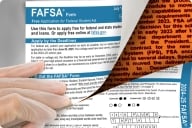You have /5 articles left.
Sign up for a free account or log in.

A report from Georgetown University’s Center on Education and the Workforce suggests cutting off graduate programs’ access to federal Grad PLUS loans if they can’t prove their program is a sound investment for students.
Nadezhda Nazarova/Getty Images
With graduate students owing nearly half of all student loan debt, policy experts are increasingly pointing to graduate education as a risky investment.
In the last year, more and more data has come out showing that graduate programs do not always pay off, particularly after the Education Department released information in August 2023 exposing a “weak” link between student debt levels and earnings outcomes, “raising concerns over financial value” of graduate programs.
A subsequent report by the Higher Education Advisory Group, a research and consulting agency focused on college access and success, also concluded that “the ultimate payoff could vary widely” depending on which institution a graduate student attends and what they study.
“Many of the horror stories we see about student debt are often from students who attended graduate school,” said Michael Itzkowitz, founder of the HEA Group. “It’s not surprising. Graduate education is one of the most unregulated markets within higher education today. We’ve just started to peel back the onion in terms of the types of outcomes these programs produce.”
The Education Department is already working to crack down on graduate programs that may leave students saddled with unmanageable debt. Under new regulations that took effect this summer, graduate programs will have to report data on enrollment, total costs and private and institutional borrowing. The department will then use that information to determine if a student’s debt burden is worth their time and money. If a graduate degree program fails the debt-to-earnings test, students have to sign a form acknowledging they’ve seen the data before they can enroll.
Now, researchers from Georgetown University’s Center on Education and the Workforce are using similar data points to support calls for even more scrutiny of graduate programs and consequences for those that leave students drowning in debt.
“Pursuing graduate education will continue to be a high-risk endeavor as long as prospective students lack the information to distinguish between programs that are worth large amounts of graduate debt and those that are not,” according to the report, “Graduate Degrees: Risky and Unequal Paths to the Top,” published last week.
Researchers analyzed federal data on the College Scorecard to determine students’ earnings by field and program, which revealed highly variable debt-to-earnings ratios.
“This uncertainty discourages graduate enrollment among students from lower socioeconomic backgrounds and marginalized racial/ethnic groups, heightening social stratification and the chronic equity challenges that afflict higher education and the labor market.”
The report’s authors specifically identified federal Grad PLUS loans—which constitute 32 percent of graduate student loan disbursements and allow graduate students to borrow enough money to cover the cost of attending their program—as part of the problem.
“High levels of borrowing permitted under the Grad PLUS loan program,” the report said, have created “limited incentive” for graduate programs “to keep costs in line with expected earnings.”
To create more incentive for transparency, the report recommended cutting off a graduate program’s eligibility for federal Grad PLUS loans if it fails to consistently pass either the debt-to-earnings test or an in-field earning premium test, which compares how much more a graduate degree holder earns than a worker with only a bachelor’s degree in the same field.
However, that’s not quite as extreme as calls from some congressional Republicans to entirely eliminate Grad PLUS loans.
“Some critics call for ending the Grad PLUS program altogether, but this would be akin to using a hatchet when a scalpel is a more appropriate tool,” said Artem Gulish, lead author of the report and senior federal policy adviser at CEW. “Our approach would ensure that valuable programs can continue to operate, while putting the brakes on runaway costs and borrowing.”
Itzkowitz, of the HEA Group, said that’s the kind of accountability graduate programs—which have nearly tripled tuition and fees since 2000—need.
“There’s a strong argument to be made that if programs are receiving federal subsidies through grants and loans, then they should be expected and shown to provide good outcomes for the students who enroll,” he said. “It’s not only important for students, but it’s also critical for taxpayers who are helping subsidize their investments.”
He added that providing information about a program’s return on investment to the front end of a student’s decision to enroll has far more potential to ease the student debt burden than politically controversial proposals to discharge existing student debt.
“Some relief to borrowers who are underwater is like putting a Band-Aid on a cut,” Itzkowitz said. “It’s critical that students are earning enough to be able to reasonably pay down their debt within a few years of graduating from any college program. This is the first step in helping to address that and moving the conversation forward.”
But policymakers will have to craft those potential solutions in a market that wants workers with advanced degrees. According to the report, employer demand for workers with graduate degrees has almost doubled over the past 40 years—from 8 percent in 1983 to 14 percent in 2021—and is expected to keep growing.
As that happens, “all of us in the higher education community need to be thinking about addressing student debt and affordability of graduate degrees,” said Suzanne Ortega, president of the Council of Graduate Schools, in a statement to Inside Higher Ed. “We all benefit from transparency. Universities and students can better understand both the direct and indirect costs of graduate education, make informed decisions about where and how much to invest, and better align resources and time with career aspirations and community needs.”
In some fields with high earning potential, there’s little question that taking out big loans pays off.
Compared to workers with bachelor’s degrees in the same field, the report found that workers with graduate degrees in social sciences—including law degrees—and health care have the highest in-field earnings premiums, at 54 percent and 47 percent, respectively. Meanwhile, the same report shows that for workers in education, public service, STEM and the arts and humanities, getting a graduate degree only boosts earning potential between 10 and 30 percent.
And among programs with available earnings and debt data, the report found that 41 percent of master’s degree programs and 67 percent of professional degree programs failed the researchers’ debt-to-earnings test, meaning that students don’t have enough discretionary income to reasonably pay back their loans.
Public Service Degrees Riskiest
Programs in social work, school counseling, teaching and communication disorders—fields in which many jobs require workers to earn graduate degrees—had the highest debt-to-earnings test failure rates, according to the report.
For that reason, the report also recommends giving grant aid to help cover the cost of attendance for people who want to work in “these crucial yet often underpaid professions” without “putting them at unnecessary financial risk.”
Jordan Matsudaira, a public policy professor at American University who previously worked in the Education Department under the Biden-Harris administration and co-author of the agency’s graduate student debt report, said that a front-end grant is “wise,” and a possible alternative to the Public Service Loan Forgiveness program, which discharges student debt after an employee works in a government or nonprofit sector job for a decade and makes 120 payments on their loans.
“We still don’t know enough about whether students truly understand public loan forgiveness when they’re deciding which program to attend,” he said. “People may not be willing to pay the large prices up front, even if they won’t have to pay it all back.”
And though there’s growing public skepticism about the value of a college degree, data does show that earning a bachelor’s in any discipline can increase a person’s lifetime earning potential compared to their peers without one.
Jason Delisle, a nonresident senior policy fellow at the Urban Institute’s Center on Education Data and Policy, said the report’s findings illustrate why that skepticism may be misplaced.
“Bachelor’s degrees seem to offer the most mobility. It’s actually the requirements around master’s degrees that should be most concerning,” he said. “We’d all be better off if people transferred their focus from dropping bachelor’s degree requirements to dropping master’s degree requirements.”








